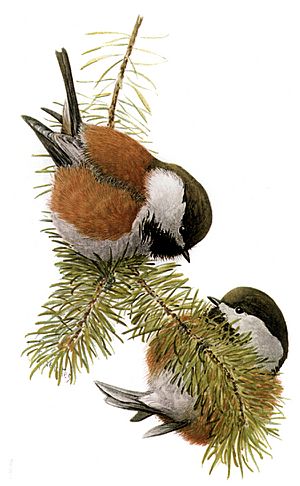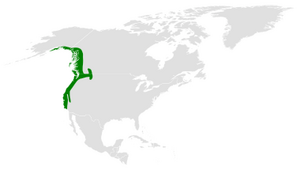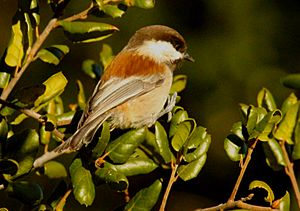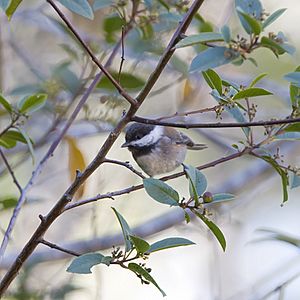Chestnut-backed chickadee facts for kids
Quick facts for kids Chestnut-backed chickadee |
|
|---|---|
 |
|
| Chestnut-backed chickadee by Louis Agassiz Fuertes | |
| Conservation status | |
| Scientific classification | |
| Genus: |
Poecile
|
| Species: |
rufescens
|
 |
|
| Range of Poecile rufescens | |
| Synonyms | |
|
Parus rufescens |
|
The chestnut-backed chickadee is a small, active bird that belongs to the tit family. You can find these birds in the Pacific Northwest of the United States and western Canada. They live from southern Alaska all the way down to southwestern California.
These chickadees usually stay in the same area all year round. Sometimes, their groups move short distances to find food, especially when winter arrives. They often move to lower places when it gets cold and then return to higher areas in late summer.
Contents
Amazing Survival Skills
Chickadees have a cool trick to survive cold winters. They can use something called hypothermia at night. This means they can lower their body temperature while they sleep.
By doing this, they save a lot of energy. Some experts believe they can save up to 32% of their energy this way! This special ability helps them live through harsh winters when other birds might not make it.
What They Look Like
The chestnut-backed chickadee is a small bird, about 11.5 to 12.5 centimeters (4.5 to 5 inches) long. It weighs about 8.5 to 12.6 grams (0.3 to 0.4 ounces).
Its head is a dark brownish-black with bright white cheeks. The back of the bird is a pretty rufous-brown color. Its wing feathers are dark gray with lighter edges. The belly is white or light grayish-white, and its sides can be rufous or pale gray. Many people think it's one of the prettiest chickadees!
These birds often travel through forests in mixed groups with other birds. You might see them with bushtits and warblers.
Where They Live and Nest
Chestnut-backed chickadees like to live in forests with conifer trees and mixed forests at lower elevations. In places like the San Francisco Bay Area, they have learned to live in suburban areas too. This has helped them spread to new places.
These birds are cavity-nesters. This means they build their nests inside holes. They often use holes that woodpeckers have left behind. Sometimes, they even dig their own holes!
Their nests are very soft and cozy. They use a lot of fur and hair to build them. In fact, about half of their nest is made of fur and hair! They often use hair from animals like deer, rabbits, and coyotes. When the adult chickadees leave the nest, they even pull a layer of fur over their eggs to keep them warm and safe. A female chickadee usually lays 5 to 8 eggs, but sometimes up to 9.
What They Eat
Chestnut-backed chickadees mostly eat insects and other small creatures without backbones. They find these by searching through leaves and branches.
They also eat some seeds, especially from conifer trees, and a little bit of fruit. You might even see them at bird feeders in your yard! They love suet (a type of bird food made from fat) and will even visit hummingbird feeders.
Family Tree
Scientists have studied the genes of these birds. They found that the chestnut-backed chickadee is very closely related to the boreal chickadee. They are like cousins in the bird world!
Images for kids
See also
 In Spanish: Carbonero dorsicastaño para niños
In Spanish: Carbonero dorsicastaño para niños







